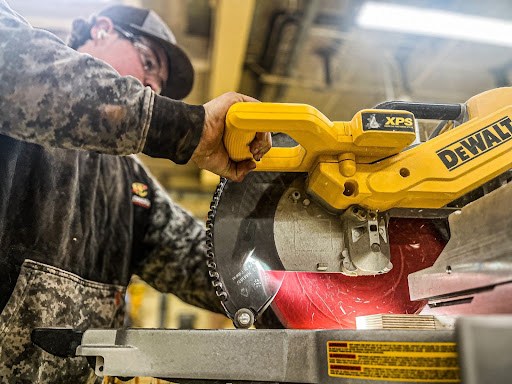Sandburg’s woodworking program is surging in popularity and student engagement, according to woodworking teacher Mr. Diorio. For the first time in years, enough students have registered to potentially separate advanced woodworking into its own dedicated course.
The hands-on elective, which has existed at Carl Sandburg High School since 1956, continues to grow in popularity as more students seek out practical, project-based classes.
Even at a school with strong hands-on electives like auto body and ceramics, woodworking stands out for its emphasis on independent project work and real-world construction skills.

For almost 70 years, the class has offered students more than just an elective credit. It stands apart from core academic courses with its emphasis on responsibility, craftsmanship, and real-world application.
“I like working with my hands and building things… and at the same time pass that knowledge on to the next generation,” says woodworking teacher Mr. Diorio.
“You’re going to walk out of this class learning how to read a blueprint, [use] a tape measure… and construct some pretty cool projects.”
Unlike a lot of classes, woodworking isn’t about worksheets or tests– it focuses more on showing up, rolling up your sleeves, and making something real.
“There’s a lot of problem solving that goes on… it’s a unique environment with so many moving parts,” said Mr. Diorio.
Senior Ian Flores adds that “We never had deadlines in this class. We had, by the end of the semester, to build something, but we didn’t know exactly. Every Monday or so we come in, there’s always something new to work on.”
The atmosphere in the shop is laid-back, but still very focused and safety oriented, with students working at their own pace on their own projects which they genuinely enjoy and are proud of.
“It’s normally very funny and silly, just an upbeat and happy class,” said Sophomore Meka Leach.
Flores adds that while safety is taken seriously, the class is refreshingly different from the rest of the school day.
“Rather than say, ‘do this quiz or test,’ we’ll do a test for general safety. After that, it is student-led work.” From using miter saws to sanding or cleaning, students say the class keeps them busy– but in the best way possible.
What starts as a simple charging station or table often becomes something more, a lesson that teaches students patience, problem-solving, or just trusting yourself to figure things out. “If you kind of make a mistake, you learn how to work with it and push through,” said Leach.
She admits she used to always struggle during Woods 1, but now feels much more confident. Flores agrees, saying “I never thought I’d be good at measuring… now I can go down to a sixteenth, even thirty-secondth of an inch.”
Mr. Diorio said watching students overcome early hesitation is one of the most rewarding parts of teaching. “I get to watch them gain the confidence and experience to actually complete a project they started.”
Beyond all the technical skills, both Flores and Leach said the class helped them think more creatively and to appreciate the craftsmanship behind everyday objects. “It puts a lot more respect into everything I see furniture-wise,” Leach added. “Now I understand how much work was put into it.”
Everything students learn in woodworking applies outside of the classroom as well. Leach said that “You could use this in your everyday life. Just to have this skill is really handy.” Whether it’s building shelves at home or picking up woodworking as a side hobby, the class teaches useful skills that apply to real-world situations.
Flores sees it as even more than that. “It helped me further my career,” he says. “You’re able to use a nail gun, you’re able to make your own resin, you clean a bunch, like a lot more than you would think, because you clean tools, you empty out entire vacuums and dust compactors… [This all] helped me further my career by allowing me to do things at my own house, figuring out if I need a miter saw, where to get one… And yeah, safety in general has furthered my career more than I thought was possible.”
With so much student interest recently, the possibility of a full Woods 3 class is starting to look more realistic than ever. “That is a dream of mine,” says Mr. Diorio. “We might be very close to having the required number of students.”
Unlike this year, where advanced students are grouped with other Woods classes such as Woods 1, a dedicated Woods 3 would allow for more freedom in project choice and deeper skill development.
“I hope to learn more about different machines and how to be more precise with measurements,” says Leach who’s already signed up for the class next year. Flores, though a Senior, says he would have taken it “100%” if he had the chance.
As interest in the program continues to grow, Mr. Diorio emphasizes that the best way to be part of Woods 3 is to start early, by enrolling in Woods 1 as a freshman or sophomore. “A lot of times I experience kids that, you know, don’t take my Woods 1 class until they’re a senior in high school, and they love it and they want to do more, but unfortunately don’t have enough time.”
Woodworking isn’t the only class in the department that has the potential to expand. “Well, we just started a new class three years ago, Math and Construction, which is a double period class that goes the entire year.”
“That is our newest class in our department, and it’s grown quite a bit. We have three of those classes running this year. We’ve grown out of the wood shop. We had to build a new lab for that class.”
Mr. Diorio also said that “I would say that there is a small amount of room for us to grow a little bit, but we’re getting very close to being topped out.” Despite the space limitations, both programs continue to attract growing interest amongst students.
Although both classes may seem very similar, the truth is far from that. “They are two sort of different things.” “In Math and Construction you’re going to learn a little bit of everything. You’re going to learn a little bit of plumbing, a little bit of electrical work. You’re going to learn about concrete and roofing and drywall. In the wood shop, we’re really just kind of focused on sort of cabinet making, woodworking, trim, finish, carpentry sort of stuff. So, you know, if you’re really into building furniture, desks, blanket chests, all that different sort of stuff, that’s going to be woodworking. If you want a more generalized sort of, ‘I want to learn a little bit of this, a little bit of that,’ ‘I really want to see how math is applied to all of that,’ then Math and Construction would be a good choice for you.”
For those who want to try and see if woodworking is right for them, every other Wednesday students meet at the wood shop for Woods Club, where most members choose to design and work on building a cutting board made out of different types of wood or building a chessboard.
Part of the reason interest keeps building is visibility —quite literally. Mr. Diorio encourages students to carry their projects through the halls instead of storing them in lockers before the end of the day. Whether it’s a chessboard, a table, or the charging station most students see towards the end of each semester, the finished pieces tend to turn heads.
As students carry their work from class to class, the program’s presence –and reputation– continues to grow.


